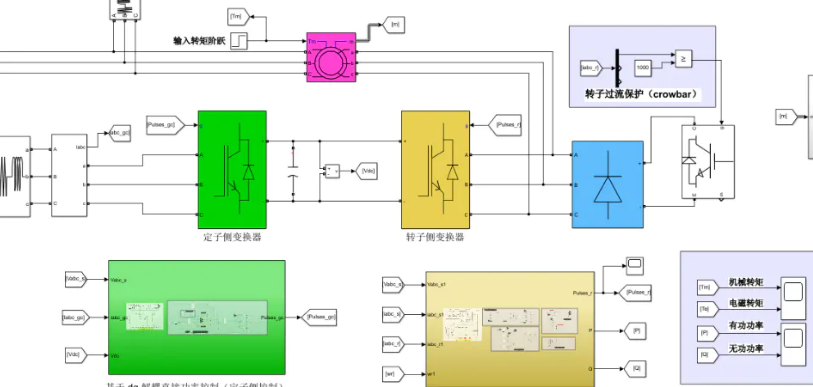【风力发电】基于Matlab的双馈风力发电机建模仿真设计

摘要
本文针对双馈风力发电机(DFIG)系统的建模与仿真,提出了一种基于MATLAB/Simulink的设计方法。双馈风力发电机在风能利用和电力输出方面具有较高的灵活性。通过MATLAB建模和仿真,验证了DFIG在不同风速条件下的性能表现。
理论
1. 双馈风力发电机概述
双馈风力发电机(DFIG)是一种广泛应用于风力发电系统的发电机类型,能够在变速情况下实现恒频输出。DFIG系统包括定子、转子、和控制系统,通过电力电子转换器实现转速和输出功率的控制。
2. DFIG的工作原理
-
定子与转子:定子连接电网,提供恒定频率的交流电;转子通过电力电子变换器与电网连接,调节转速以适应不同风速。
-
控制策略:利用矢量控制技术,通过调整转子电流,实现有功和无功功率的独立控制,从而提高系统稳定性和输出质量。
实验结果
在MATLAB/Simulink环境下搭建了DFIG模型,并进行了不同风速条件下的仿真。通过调整风速输入,观察了DFIG的转子转速、输出电压和频率等参数,实验结果展示了该模型在动态响应方面的表现。
-
实验参数:包括定子和转子参数、控制器增益、风速范围等。
-
实验分析:通过仿真结果分析,DFIG在不同风速条件下保持了良好的电压和频率稳定性。
-
图示结果:仿真图展示了定子电压、转子电流以及输出功率随时间变化的曲线。

部分代码
% MATLAB code for modeling a DFIG in a wind turbine system
clear;
clc;
% Define DFIG parameters (example values, adjust as needed)
R_stator = 0.01; % Stator resistance
L_stator = 0.1; % Stator inductance
R_rotor = 0.01; % Rotor resistance
L_rotor = 0.1; % Rotor inductance
L_m = 0.09; % Mutual inductance
% Wind speed input
windSpeed = 12; % m/s (example value)
% Simulink model setup
open_system('DFIG_WindTurbine_Model'); % Replace with actual Simulink model name
set_param('DFIG_WindTurbine_Model/Wind Speed', 'Value', num2str(windSpeed));
% Run simulation
simOut = sim('DFIG_WindTurbine_Model');
voltage_output = simOut.get('voltage_output');
current_output = simOut.get('current_output');
% Plot results
figure;
subplot(2,1,1);
plot(voltage_output.Time, voltage_output.Data);
title('Stator Voltage Output');
xlabel('Time (s)');
ylabel('Voltage (V)');
subplot(2,1,2);
plot(current_output.Time, current_output.Data);
title('Rotor Current Output');
xlabel('Time (s)');
ylabel('Current (A)');
参考文献
❝
Leonhard, W. (2001). Control of Electrical Drives. Springer Science & Business Media.
Ackermann, T. (2005). Wind Power in Power Systems. John Wiley & Sons.
Muller, S., Deicke, M., & De Doncker, R. W. (2002). Doubly fed induction generator systems for wind turbines. IEEE Industry Applications Magazine, 8(3), 26-33.
(文章内容仅供参考,具体效果以图片为准)
